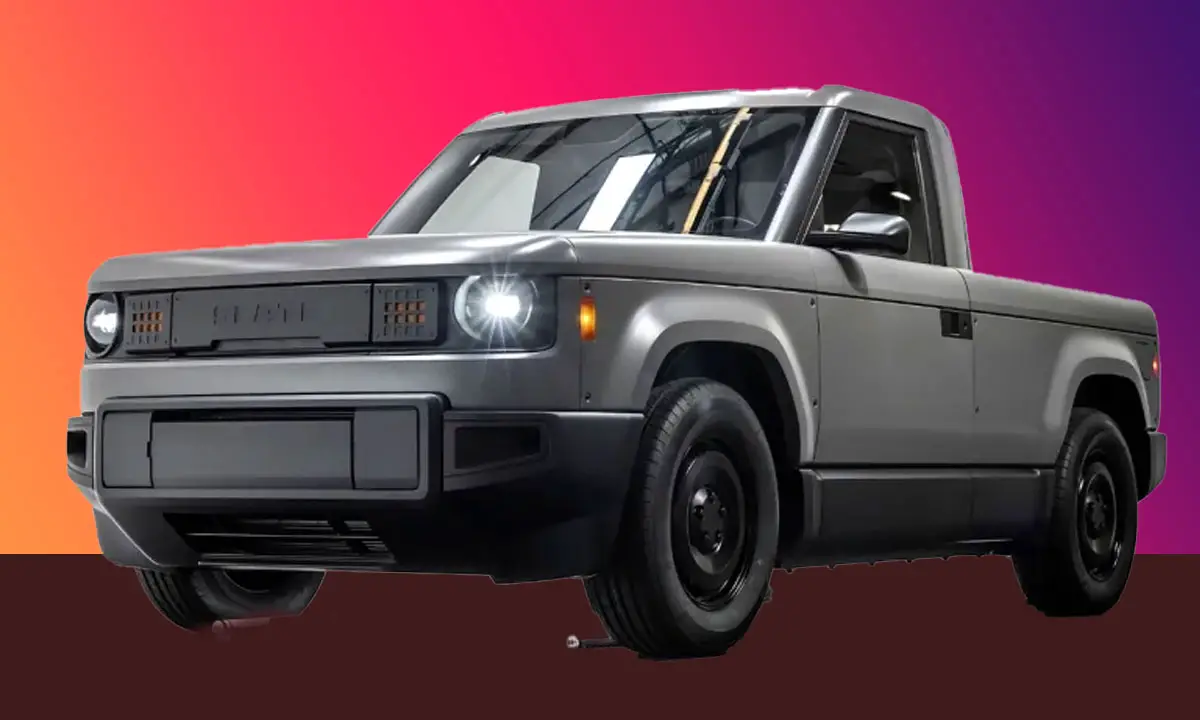Slate Auto’s $27,000 Electric Truck Is Poised to Revolutionize Affordable EV Mobility
In an era when electric vehicles (EVs) are increasingly associated with luxury, high-tech features, and price tags that often start well above $40,000, a bold newcomer is challenging the status quo. U.S.-based startup Slate Auto, supported by tech and logistics titan Amazon, is preparing to make waves with its $27,000 all-electric pickup truck—a minimalist, modular, and radically affordable vehicle designed to bring electric mobility to the masses.
Expected to debut in 2027, the Slate Truck is more than just another addition to the EV lineup; it represents a deliberate and philosophical shift in automotive design, engineering, and accessibility. With affordability at its core and a user-first design ethos, the truck aims to disrupt the premium-heavy EV market by offering a back-to-basics vehicle that still allows room for personal customization and emotional connection.
Rethinking the EV Experience from the Ground Up
Slate Auto’s mission is deceptively simple: make electric mobility accessible without sacrificing quality, durability, or personality. But achieving this has required radical decisions that most automakers shy away from. While legacy manufacturers pile on layers of tech—touchscreens, voice assistants, connected services, and AI-based dashboards—Slate is intentionally moving in the opposite direction.
Instead of dazzling customers with gimmicks, the company is embracing a clean-slate approach, pun fully intended. Every design decision is focused on utility, simplicity, and cost-efficiency. The result is a vehicle that doesn’t try to impress with flashy features but wins hearts through practical design and compelling price points.
Tisha Johnson: The Creative Force Behind Slate’s Disruption
At the heart of Slate Auto’s bold new vision is Tisha Johnson, the company’s Chief Design Officer. Her unconventional design background has played a pivotal role in shaping the philosophy behind the Slate Truck. Johnson’s career spans multiple industries and disciplines, including her time at Volvo’s North American design studio, appliance leader Whirlpool, and renowned furniture manufacturer Herman Miller.
This eclectic design résumé has informed her approach to automotive design: pragmatic, emotionally resonant, and deeply user-centric.
“I’ve always wanted to deliver affordable mobility,” Johnson said during her appearance on the Autocar Meets podcast at the Car Design Event in Munich. “And the opportunity to have a meaningful impact on people’s lives through design made Slate the right place for me.”
Johnson brings the sensibility of an industrial designer who understands the emotional connection people have with their everyday tools—whether it’s a chair, a refrigerator, or a car. She believes that design should elevate functionality and never exist for its own sake. Her work at Slate is driven by one central question: How can we create a vehicle that fits into people’s lives without overwhelming them?
Minimalist by Design, Not by Default
The Slate Truck’s most radical feature is its simplicity. At first glance, some might assume its spartan cabin is the result of budget constraints or design compromise. But according to Johnson and the design team, this restraint is entirely intentional.
Rather than investing in high-cost infotainment systems and digital dashboards, Slate took a refreshingly different route. There’s no built-in touchscreen, no proprietary software suite, and no endless rows of buttons or voice commands. Instead, drivers are encouraged to use the devices they already own—smartphones or tablets—as their control centers. A simple mount on the dashboard allows for seamless integration.
“We respect that people already have the tech they want,” Johnson explained. “We’re not crowding the dashboard with redundant screens. Let them drive—simply and affordably.”
This “device-agnostic” philosophy reduces complexity, slashes costs, and minimizes electronic waste. It’s also a subtle critique of the over-engineering trend in today’s car market, where many features add to cost but not necessarily to user value.
Manual seat adjustments, robust cloth upholstery, and straightforward analog controls define the truck’s interior. It’s a throwback to a time when vehicles were tools first, and gadgets second—but with modern engineering and battery technology under the hood.
Modular Customization: Empowering the User

Despite its minimal base configuration, the Slate Truck doesn’t force buyers into a one-size-fits-all box. On the contrary, it embraces individuality and flexibility through an innovative suite of modular add-ons and customization kits.
At launch, buyers will be able to transform the truck’s body using DIY body kits developed by Slate. These allow the base model to morph into different styles, such as a boxy SUV or a sleek fastback crossover. It’s a modular system that empowers users to reimagine their vehicles based on changing needs or personal tastes—without needing a brand-new car.
Additional personalization options include a wide variety of paint schemes, wheel styles, roof racks, bumpers, and exterior cladding. Whether you’re a contractor looking for a tough utility vehicle or a lifestyle driver chasing weekend adventures, the Slate Truck can be shaped to fit.
“We’ve created a base vehicle full of possibilities,” Johnson said. “From there, people can build something they truly love.”
This modularity also extends the vehicle’s lifecycle. Rather than trading in a car every few years, owners can simply reconfigure it, reducing waste and ownership costs.
Built in America, Designed for American Roads
Slate Auto is keeping things local—at least for now. The trucks will be manufactured in Indiana and engineered to comply with U.S. light commercial vehicle standards. This includes considerations for road size, load-bearing capacity, safety regulations, and emissions-free operation.
While there’s strong interest in the product internationally—particularly in Europe and the UK—the company is remaining focused on the domestic market. However, thanks to the UK’s relatively lenient import policies for electric vehicles, British drivers may still find ways to get their hands on a Slate Truck through third-party importers once the vehicle becomes available in the U.S.
This U.S.-centric strategy is also a nod to the unique needs of American drivers, particularly in rural and semi-rural areas where light trucks and pickups remain a staple. By offering an affordable, electric alternative in this space, Slate is targeting a market that has long been underserved by traditional EV offerings.
The Bigger Picture: A Challenge to the Industry
The timing of Slate’s announcement couldn’t be more impactful. The electric truck market is currently dominated by high-end vehicles like the Ford F-150 Lightning, Tesla Cybertruck, and Rivian R1T—all priced well above $50,000. These models are loaded with luxurious features and performance metrics that appeal to affluent buyers, but they leave out a massive portion of the driving public.
Slate’s $27,000 truck is a direct challenge to that market dynamic. It dares to ask whether people really need 600 horsepower, autopilot systems, and augmented reality windshields—or whether what they truly need is reliable, affordable, and adaptable electric transportation.
And the answer, if early interest is any indicator, may surprise the industry.
Analysts believe that Slate’s success could have a domino effect, forcing larger automakers to rethink their strategies. Instead of competing solely on features, speed, or tech sophistication, the market could shift toward practical value, long-term durability, and user-focused design.
A Vehicle Born From Purpose, Not Profit
There’s also a philosophical dimension to Slate Auto’s approach. Unlike many startups looking for a fast IPO or acquisition, Slate appears to be playing the long game. The company is committed to creating a viable alternative for middle-income drivers who have been priced out of the EV revolution.
By partnering with Amazon, Slate gains access to logistical support, infrastructure investment, and a potential fleet customer base. But the vision remains rooted in democratization—making electric vehicles not just a status symbol, but a realistic choice for everyday Americans.
“It’s an intentional turn in a different direction,” Johnson said. “One that prioritizes simplicity, affordability, and joy. That’s the kind of future we want to build.”
A Simpler, Smarter, More Inclusive EV Future
As the automotive world races toward electrification, Slate Auto stands out for slowing down and asking the right questions. What do people really need in a vehicle? How can we make electric mobility more inclusive? And is it possible to fall in love with a truck that costs less than a third of the price of a Tesla?
Slate’s answer to all of these is a resounding yes.
With production scheduled to begin in 2027, all eyes are now on the startup to see if it can deliver on its promises. But even before the first truck hits the road, Slate Auto has succeeded in starting a vital conversation about what the future of transportation should look like—not just for the wealthy, but for everyone.

